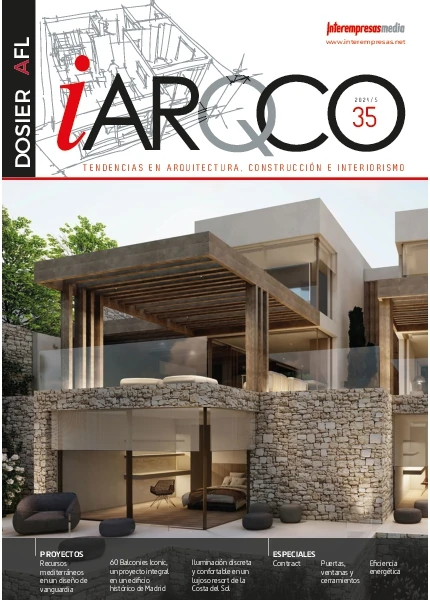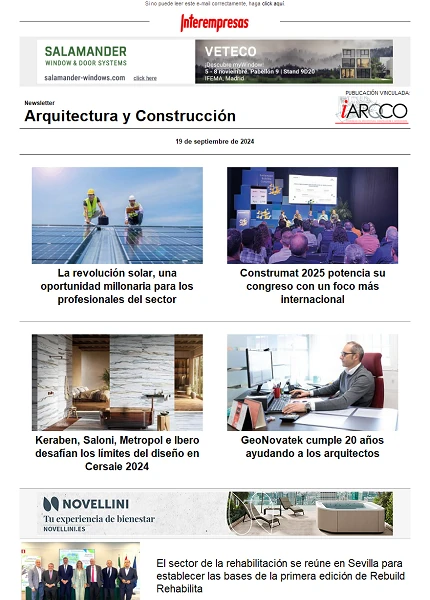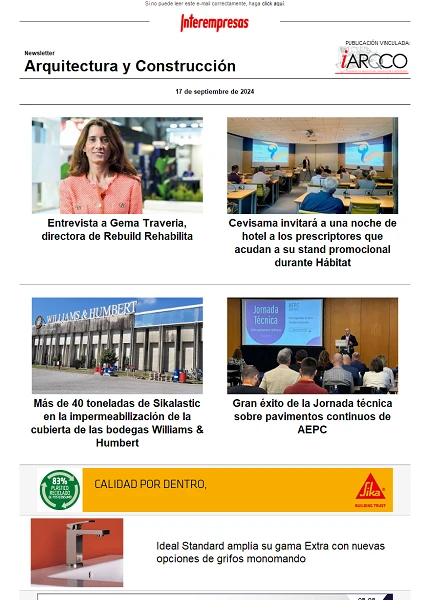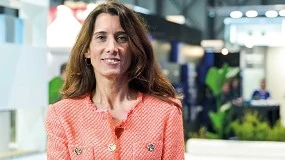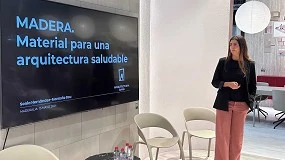Las cúpulas de doble curvatura
Las estructuras laminares, o cáscaras, son superficies delgadas, curvas, de poco espesor, comparado con las dimensiones globales de la estructura. Las superficies se distinguen por su generación en superficies de revolución, de traslación y regladas. Su alabeo es variación de curvatura. Su pandeo es la flexión de un elemento recto. En la lámina los esfuerzos de tracción y compresión son máximos y los de corte nulos. Las zonas más débiles serán las de menor curvatura y las de contacto con los elementos de anclaje, donde las tensiones son mayores. La membrana es una hoja de material tan delgada, que no puede desarrollar compresiones, es decir, no tiene rigidez. La tendemos entre elementos comprimidos, mástiles y anillos.

Los diseños biológicos de la Naturaleza con sus caparazones y conchas nos muestran cómo lograr envolventes de forma adecuada para cubiertas con poco peso. Resisten por su forma las cargas de peso propio y las cargas exteriores mediante esfuerzos normales de compresión y/o tracción, y tangenciales. Son membranas tendidas entre puntos de anclaje. Su eficiencia se debe a su estructura y al alabeo de los planos. Membranas de doble curvatura, sometidas a tensión, sin ninguna compresión, pueden resistir cargas perpendiculares a su superficie. Nos recuerda la tela de un paraguas. La arquitectura textil emplea materiales tensados, tejidos, láminas, el término correcto es Tensile Architecture, en inglés.
En la antigüedad las cúpulas se construían de piedra o mampostería, pasando luego por el ladrillo, e incluso, la madera. Los romanos las usaron mucho, la mayor es la del Panteón de Roma (años 120-124), con 44 m de diámetro, hecha de hormigón en masa. El empleo de telas en construcciones es muy antiguo: el circo ambulante con lino, o lona de cáñamo, con diámetros de hasta 50 m. Esa cobertura cumple siempre dos condiciones: doble curvatura y está pretensada. Las cubiertas antiguas eran de membrana tensada, no pretensada. Es interesante ver la evolución desde la antigua tienda cónica, apoyada en un soporte vertical, hasta las cubiertas de membranas pretensadas, que exigen doble curvatura, muy poco deformables ante la acción de las cargas.
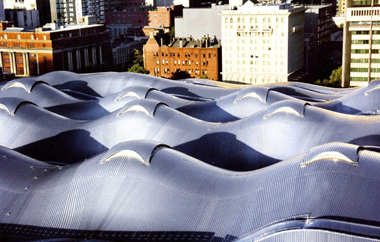
En el siglo XX se abandonan las cúpulas tradicionales, y con hormigón armado se cubren espacios de grandes luces, con superficies delgadas de pequeño espesor. La 1ª cáscara delgada es la cúpula del Zeiss Planetarium (Jena 1925) de 6 cm de espesor, 25 m de diámetro y 12,5 m de altura, obra de Walter Bauersfeld. La armadura está formada por una malla triangulada de acero, sobre la que se vierte el hormigón. Hoy día la mayoría de los estadios, terminales de aeropuerto y grandes centros comerciales están cubiertos por membranas tensadas, con superficies superiores a los 100.000 m2.
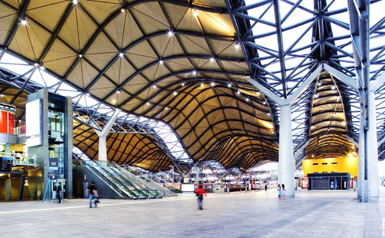
Requieren mínimos elementos de soporte de estructura rígida, y permiten un nivel de luz natural diurna aceptable. La membrana es capaz de soportar las cargas que se requieren en el Código Técnico de Edificación. En países fríos el refuerzo de la membrana permite afrontar la incidencia de una nevada. Las cubiertas tensadas emplean mástiles, tensores y cables, para tensar la lámina por sus extremos, en direcciones y sentidos opuestos, incluso fuera de plano. Las ventajas sobre la cubierta antigua convencional son un peso mínimo. Su coeficiente de transmisión de luz nos permite prescindir del vidrio, con sus inconvenientes de peso y rigidez. Las membranas comúnmente usadas transmiten el 13-16% de la luz solar incidente.
La membrana se recibe en rollo, que hay que cortar según el diseño. Los patrones cortados se han de unir para formar la cubierta. Hay uniones cosidas, soldadas por alta frecuencia, ultrasonido, pegadas, etc. Luego hay que unir la membrana a los mástiles perimetrales, para transferir los esfuerzos normales, o tangenciales, de la membrana al sistema de borde. Existen bordes flexibles curvados y bordes rígidos. Finalmente están los mástiles intermedios o perimetrales (pivotantes, o articulados), necesarios para lograr la tensión adecuada.

El EFTE ha transformado la arquitectura de las 3 últimas décadas. EFTE es el acrónimo de Etileno Tetra Fluoro Etileno. La resina es el copolímero de esta molécula, un plástico transparente de extraordinaria durabilidad. Posee una elevada resistencia química y mecánica al corte y a la abrasión, y soporta hasta 170 °C. La resina es procesable por extrusión y moldeo por inyección. Su cualidad más destacable es su elevada resistencia a los rayos ultravioleta; por ello no amarillea durante su exposición a la luz solar. Es la alternativa al vidrio en la construcción. El EFTE pesa 100 veces menos que el vidrio. En España tenemos EFTE en la cúpula del Milenio, en la plaza del Milenio, Valladolid.
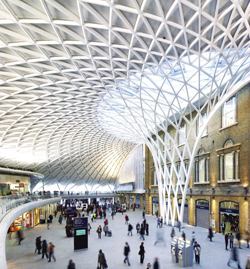
Curvatura simple y doble
Es simple (curvatura desarrollable) cuando la curvatura en un punto dado es del mismo signo en todas las direcciones, excepto en una de ellas: la recta generatriz, que vale 0. Por ejemplo: cilindros y conos. Los valores de pretensado son muy inferiores a la resistencia máxima de la membrana, pero son suficientes para compensar las pérdidas por fatiga del material a lo largo del tiempo. La solución ante las cargas son las redes triangulares, por su capacidad para resistir cualquier sistema de fuerzas de tracción y compresión.
Hay dos clases de curvatura doble, no desarrollable:
(A) Sinclásticas: La curvatura en un punto dado es del mismo signo en todas las direcciones, el centro de curvatura está en el mismo lado de la membrana: ejemplos, la esfera, el paraboloide elíptico, etc.
(B) Anticlásticas: Dos centros de curvatura a ambos lados de la membrana. La curvatura en un punto es positiva en algunas direcciones, y negativa en otras: el paraboloide hjiperbólico, la silla de montar. Geométricamente las superficies anticlásticas resultan de trasladar una curva sobre otra, de curvatura inversa (el paraboloide), o por la rotación de una curva alrededor de un eje (el catenoide). La doble curvatura aporta una doble acción de arco.
Entre las superficies anticlásticas interesan particularmente aquellas que son regladas, esto es: pueden obtenerse por el desplazamiento o rotación de una recta sobre otra familia de curvas, resultando una superficie alabeada. Como su característica es la existencia de dos curvaturas opuestas, desarrollarán siempre una doble acción de arco y cable, además de la acción de corte resultado del alabeo. La doble curvatura es más eficiente que la curvatura simple. Para que una superficie no desarrolle esfuerzos de flexión, la condición necesaria es que no pueda deformarse, y esto solo ocurre, si la curvatura es doble. Pero es sensible al pandeo, consecuencia de su mínimo espesor.
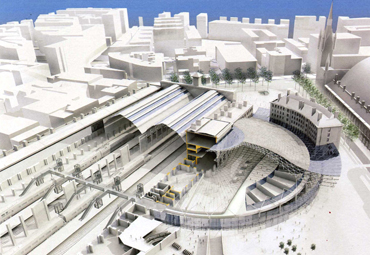
Las superficies regladas más empleadas son el conoide, el helicoide, el hiperboloide y el paraboloide hiperbólico. Las superficies de la techumbre pueden generarse por rotación o traslación. En el primer caso la curva gira alrededor de un eje llamado de rotación, mientras que en el segundo se mueve paralelamente a sí misma. Son superficies de revolución: la esfera, el paraboloide, el hiperboloide y el cilindro.
Si la superficie puede describirse por el movimiento de una línea recta, se llama superficie reglada, como el cilindro y el cono.
Estructura de la techumbre
Una membrana ideal es una hoja de material, tan delgada en comparación con sus dimensiones laterales que solo puede desarrollar tracciones que serán bidimensionales a lo largo de su superficie. Al ser de pequeño espesor la rigidez a flexión y la cortante es despreciable. Igualmente la resistencia a compresión, puesto que de lo contrario, con una compresión pequeña pandearía.
La estabilidad de las membranas se debe a su geometría y a las tensiones que desarrolla bajo la carga. La teoría de la membrana se toma como base para el diseño de superficies curvas. Pero no refleja necesariamente la verdadera distribución de tensiones, ya que se asumen condiciones estáticamente determinadas. Esta aproximación es válida para entender la estructura, ya que el análisis real es complejo.
Las superficies reales son lo suficientemente delgadas como para considerar despreciables las tensiones de flexión, pero lo suficientemente gruesas como para no pandear bajo pequeñas tensiones de compresión. Las cargas superficiales se soportan no solo a través de tracciones superficiales, sino también por medio de compresiones superficiales.
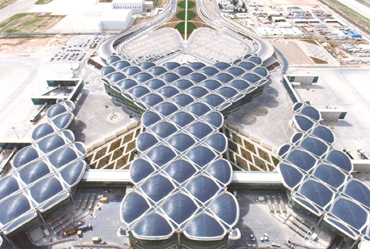
El material más idóneo es el hormigón armado o pretensado, pero también se usa la madera, los metales, los plásticos reforzados. En general las tensiones de membrana suelen ser pequeñas, por lo que muchas veces el espesor de las estructuras laminares viene determinado por los momentos inducidos por los elementos de apoyo. A pesar de esto, las fuerzas de membrana deben evaluarse por varias razones:
- Determinar dónde se desarrollarán tensiones para disponer la armadura, o refuerzo adecuado, si el material trabaja fundamentalmente a compresión.
- Determinar cuál es la tensión de compresión mayor, con el fin de comprobar el pandeo.
- Determinar los desplazamientos de los extremos y las tensiones de flexión que se producen al limitar total o parcialmente estos desplazamientos.
Las membranas no son adecuadas para resistir cargas puntuales, por lo que deben evitarse siempre que sea posible, pues se puede producir un colapso local.
Las cúpulas
Son superficies de revolución definidas por la rotación de una curva plana alrededor de un eje vertical. Permiten cubrir grandes luces, incluso un diámetro de 100 m, y encerrar la mayor cantidad de espacio con la mínima superficie. Por ello resultan muy aptas para cubrir estaciones ferroviarias, campos de deporte, piscinas, palacios de congresos, salas de exposiciones, etc. en donde se necesita que los espacios interiores sean diáfanos.
Si pensamos en una esfera sometida a presión interior, las dos familias de direcciones principales son los paralelos y meridianos trabajando a tensión. Si la presión es exterior, es muy intuitivo ver que los meridianos trabajan a compresión, como arcos, y los paralelos los atan, de modo que aquellos no pandean. Un casquete muy rebajado trabaja todo él comprimido.
Para hacerse una idea del nivel de eficacia mecánica de la cúpula, baste recordar que son suficientes espesores del orden de 1/400, veinte veces menores que los de las vigas de luz equivalente. Como todo cascarón la cúpula tendrá una limitación por pandeo, que requerirá aumentar su espesor. La triangulación de la esfera se aplicó primero a los recuadros formados por la red de meridianos y paralelos, siglo XIX.
Otra solución para la esfera indeformable consistió en la cúpula geodésica, que resulta de proyectar un icosaedro sobre la superficie esférica. La aplicación del tensado es típica en el anillo de borde, para contrarrestar los esfuerzos de tracción, el paralelo de apoyo.
La mayoría de las cúpulas actuales son casi hemisféricas, para evitar los empujes laterales, ya que cuando son más rebajadas se necesitan anillos de tracción para resistirlos. La cúpula esférica resiste la carga con un sistema de fuerzas internas situadas en su superficie. Normalmente suele haber una fuerza principal de compresión a lo largo de los meridianos, verticalmente, y una fuerza horizontal menor, generalmente de tracción, actuando alrededor de ella, en los paralelos.
Para que la teoría de la membrana pueda aplicarse a la cúpula debe estar soportada uniformemente a lo largo de sus bordes. Por otra parte el desplazamiento de la cúpula debe ser compatible con el desplazamiento de la estructura sustentante, hecho que no suele ocurrir en la realidad. Esta incompatibilidad produce flexiones, aunque suelen quedar limitadas a las zonas próximas a los bordes.
El espesor habitual de las cúpulas de hormigón armado varia de 7,5 cm a 11,5 cm para luces de 30 a 60 m, con un aumento de espesor de un 50 a un 75% en la periferia. Si las luces son mayores se aumentará su espesor, se rigidizará con nervios, o bien, se formará una doble capa, para evitar el pandeo a compresión.
En España un ejemplo de este tipo de estructura es la cúpula esférica del Mercado de Algeciras (1934-1935, de Manuel Sánchez Arcas y Eduardo Torroja) con un diámetro de 47,8 m y 10 cm de espesor. La cúpula cubre un espacio octogonal, de 18,2 m de lado, y descansa sobre 8 pilares, en cada una de las esquinas. La tensión de tracción horizontal se absorbe mediante un anillo octogonal, que une los extremos superiores de los soportes.
El paraboloide hiperbólico
Es una superficie reglada de doble curvatura total negativa, pues los centros de los radios de curvatura de cada juego de curvas están ubicados en lados opuestos de la superficie. Es decir, se puede generar por dos familias de parábolas de curvatura opuesta, o bien por dos familias de rectas a 45º con los planos de las parábolas. Es una superficie sin alabeo. La membrana, si tiene 4 apoyos, son 4 soportes que no se encuentran en el mismo plano. La doble curvatura aumenta la rigidez de la cáscara. Los elementos rectos de borde resultan traccionados o comprimidos y libres de flexiones.
La silla de montar está generada por dos familias de generatrices rectas, que permite ser hormigonada sobre un sencillo encofrado realizado a base de tablas de madera, que siguen sus generatrices rectas. En la dimensión 2 encontramos las curvas cónicas: elipse, parábola e hipérbole, y en la dimensión 3 tenemos las superficies cuádricas. Estas superficies tienen que ver con las curvas que aparecen como secciones con planos: en el paraboloide hiperbólico estas secciones son parábolas e hipérbolas.
Gaudí fue uno de los que la emplearon, pero quien más la ha trabajado ha sido Félix Candela. Su interés fue motivado por el hecho de que el paraboloide hiperbólico, aun siendo una superficie curvada, se puede construir con listones rectos. Lo único que se tiene que hacer es ir variando el ángulo de inclinación de una recta que se mueve encima de otra curva, es la superficie reglada. Gaudí dio las instrucciones precisas al capataz y a sus obreros, cuando éstos construían un paraboloide hiperbólico en el techo de la Sagrada Familia, de Barcelona, iniciada en el año 1883.
El proceso de construcción del paraboloide sigue estos pasos: Dados 4 puntos en el espacio, que no estén en un mismo plano, hay un único paraboloide hiperbólico que pasa precisamente por estos 4 puntos. Esta es la misma propiedad que dice que dos puntos determinan una única recta. Tanto Gaudí como Candela aprovecharon las superficies matemáticamente definidas, con unas ecuaciones perfectamente determinadas y una manera de construirlas totalmente establecida. Esto indica la carencia de libertad de estos arquitectos en el diseño de la forma deseada en sus maquetas. Solo podían utilizar una familia de superficies, dependiendo de unos pocos parámetros.
El comportamiento de membrana con fuerzas axiales y tangenciales constantes a lo largo de la superficie se basa en una situación ideal bajo carga uniforme, y sin tensiones adicionales debidas a los soportes, situación que no coincide exactamente con la realidad.
El hecho de que la carga no sea uniforme, que no esté articulada en el contorno, que no sea despreciable la rigidez de los elementos de borde en el plano de la superficie, conduce a la existencia de esfuerzos de flexión y esfuerzos cortantes, adicionales a las zonas próximas a los bordes. Puede considerarse adecuada la aproximación a la membrana, si el cociente luz/altura es del orden de 9, y la pendiente de las vigas de borde, para piezas rectangulares, varia de 1/5 a 1/3.
Eduardo Torroja en 1935 construyó el hipódromo de la Zarzuela, Madrid, con una marquesina consistente en una batería de láminas cilíndricas adosadas en un gran voladizo de muy poso espesor. Pero la riqueza visual y arquitectónica del paraboloide hiperbólico ha sido explotada por el mexicano Félix Candela, después de la segunda guerra mundial. Algunas de sus obras son el pabellón de los Rayos Cósmicos (Universidad Autónoma de México, 1951) formado por dos paraboloides hiperbólicos paralelos, de 1,5 cm de espesor. Otra obra de Félix Candela es el Restaurante submarino del Oceanografic, de Valencia (2002).
Los materiales
Los tejidos y las redes de cables son los dos materiales más desarrollados, para trabajar en tracción y admitir doble curvatura. El cable metálico es el que tiene más prestaciones, dada su resistencia de rotura y alto límite elástico, poca deformabilidad. Puede incorporar protecciones como el galvanizado, o enfundarse con materiales plásticos. El elemento fundamental de la cuerda es el anclaje, que puede ser una simple rosca en el alambre macizo. También son posibles anclajes curvados en macizos de hormigón. Todos ellos son puntos débiles.
Las membranas textiles son de materiales compuestos en los que la armadura puede ser de fibra de vidrio, o poliéster, y el recubrimiento de PVC, PTFE o silicona. La fibra de vidrio recubierta de PTFE es mucho más permanente. Con fibra de vidrio-PTFE se alcanzan transparencias del 16%; con silicona del 80%. Hay que recordar que son materiales direccionales, debido a la orientación y entrecruzamiento de fibras.
Cubiertas laminadas recientes
Southern Cross Station, Melbourne, Australia.
Ha sido diseñada por Grimshaw Jackson Arquitectos, y construida en tres años: 2004-2007, con una superficie de 60.000 m2, superficie cubierta 36.700 m2. El cliente es Spencer Street Station Authority, Victorian Government. Coste 439 millones de euros. Con cúpulas de curvatura doble.
King's Cross Station, Londres.UK.
Diseñada por John McAslan + Partners Arquitectos. Cliente Network Rail. Entregada la Obra en 2013. Superficie 8.000 m2. Coste 600 millones de euros. Cubierta de curvatura doble.
Queen Alia International Airport. Amman, Jordania.
Diseñado por Foster + Partners Arquitectos. Cliente The Hashemite Kingdom of Jordan Ministry of Transport. Airport International Group. Comienzo de las obras en 2007. Terminado el primer Terminal en 2013, continúan las Obras en el 2º Terminal, finalizarán en 2014. Superficie 116.000 m2. 99 cúpulas de sección esférica sobre planta cuadrada.
Referencias
- Araujo, R. Estructuras laminares. ATC Ediciones Madrid 2007.
- Basset, Ll. Estructuras laminares. Universitat Politècnica de València 2008.
- Gargollo, M. Estática de las bóvedas. Escuela de Bellas Artes, Madrid 1911.
- Huerta, S. Arcos, bóvedas y cúpulas. Geometria y equilibrio. Instituto Juan de Herrera, Madrid 2004.
- Sánchez MªR. Las membranas pretensadas. Facultad de Arquitectura. Buenos Aires, Argentina 2003.
- Valenzuela, P. Las membranas tensadas. Editorial Wagg, Buenos Aires, Argentina 2012.


